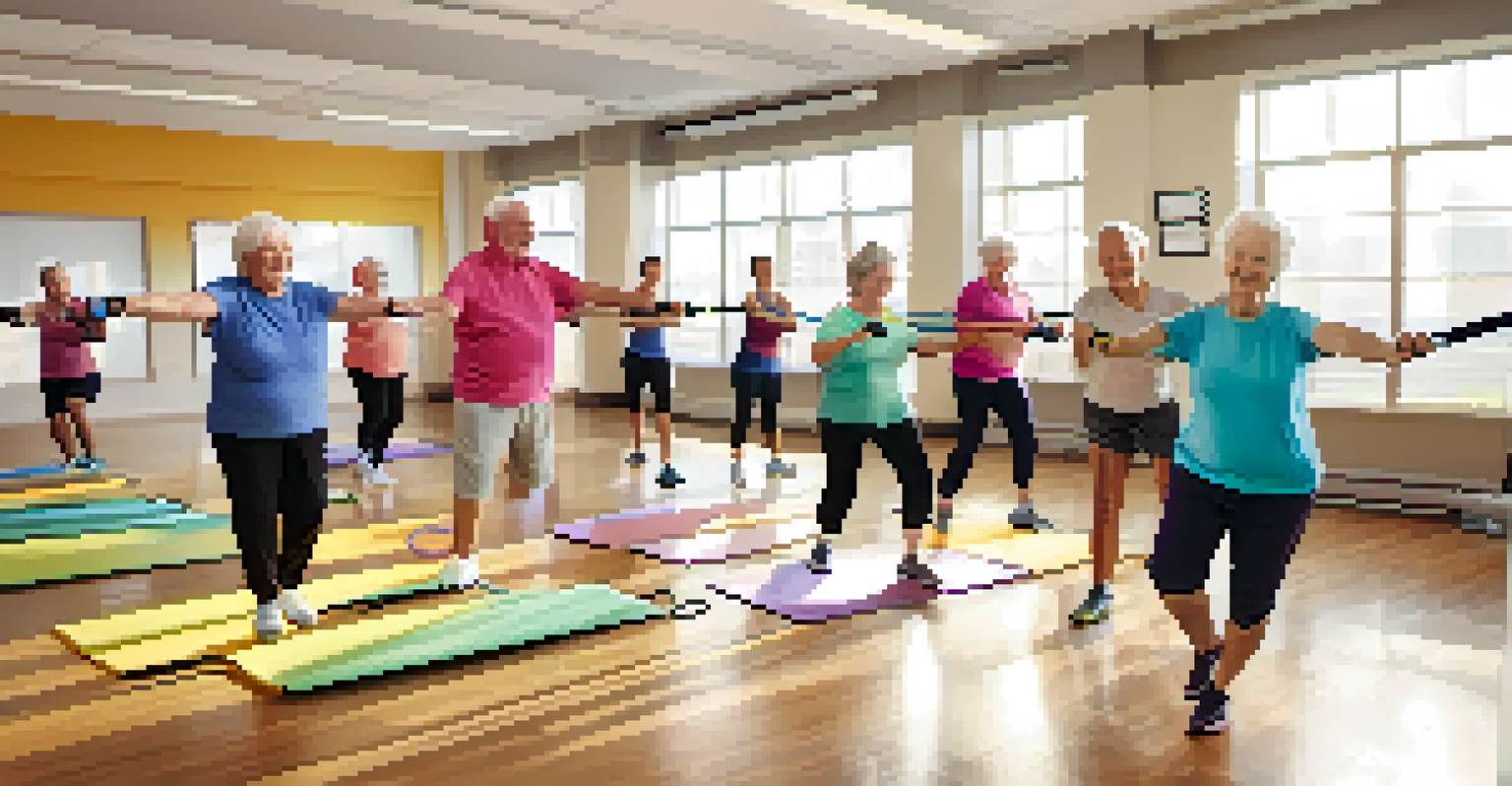Using Resistance Training to Improve Seniors' Quality of Life

Understanding Resistance Training and Its Importance
Resistance training, often known as strength training, involves exercises that improve muscle strength by working against an external force. For seniors, this type of training is especially vital as it helps combat the natural decline in muscle mass and strength that comes with aging. Engaging in these exercises can lead to improved mobility and independence, allowing older adults to maintain their daily activities with ease.
Strength does not come from physical capacity. It comes from an indomitable will.
Moreover, resistance training can significantly enhance bone density, reducing the risk of fractures and osteoporosis. This is crucial since falls are one of the leading causes of injury among seniors. By incorporating strength-building activities into their routine, older adults can build a stronger foundation to support their overall health.
In addition to physical benefits, resistance training can have profound mental health advantages. Regular exercise is known to release endorphins, which can improve mood and reduce feelings of anxiety and depression. Thus, the importance of resistance training goes beyond the physical realm, positively impacting seniors' quality of life.
Physical Benefits of Resistance Training for Seniors
One of the most significant physical benefits of resistance training is increased muscle strength. As seniors engage in regular strength exercises, their bodies adapt, leading to improved muscle tone and endurance. This increase in strength translates to better performance in daily activities, such as climbing stairs or carrying groceries, fostering a sense of independence.

Additionally, resistance training enhances balance and coordination, which are crucial in preventing falls. Exercises like squats and lunges help strengthen the muscles that support the hips and knees, making it easier to navigate uneven surfaces. The result is not only a lower risk of injury but also greater confidence in movement.
Boost Muscle Strength and Mobility
Resistance training helps seniors improve muscle strength, mobility, and independence, making daily activities easier.
Moreover, regular resistance training can improve overall body composition. With increased muscle mass, seniors can boost their metabolism, making it easier to maintain a healthy weight. This is particularly important as weight management is often a concern for older adults, affecting their overall health and well-being.
Mental Health Improvements Through Resistance Training
Engaging in resistance training can significantly boost mental health among seniors. The act of exercising releases neurotransmitters like serotonin and dopamine, which are responsible for feelings of happiness and well-being. As seniors experience these positive effects, they may find their overall mood improving, leading to a more fulfilling life.
The greatest wealth is health.
Furthermore, the discipline and focus required during resistance training can help sharpen cognitive function. Studies show that physical activity increases blood flow to the brain, which can enhance memory and cognitive abilities. This connection between physical and mental health highlights the holistic benefits of incorporating strength training into a senior's routine.
In addition to these benefits, the social aspect of participating in group resistance training classes can enhance emotional well-being. Seniors often enjoy the camaraderie and support found in these settings, helping to combat feelings of loneliness or isolation. Building relationships with others who share similar health goals can be incredibly encouraging and uplifting.
How to Get Started with Resistance Training
Starting a resistance training program doesn't have to be intimidating. Many seniors find it helpful to begin with body-weight exercises, like push-ups or sit-to-stands, which are gentle on the joints. Gradually incorporating light weights or resistance bands can add variety and challenge without overwhelming the body.
It's essential to consult with a healthcare provider or a fitness professional before beginning any new exercise regimen, especially for those with pre-existing conditions. They can help create a personalized plan that considers individual capabilities and goals, ensuring a safe and effective experience.
Enhance Mental Well-Being
Regular resistance training releases mood-enhancing neurotransmitters, improving mental health and cognitive function.
For those who prefer a more structured approach, joining a senior fitness class can provide guidance and motivation. Many community centers and gyms offer specialized programs tailored to older adults, focusing on strength training in a supportive environment. This not only helps in learning proper techniques but also fosters a sense of community.
Safety Considerations in Resistance Training for Seniors
Safety is paramount when it comes to resistance training for seniors. It's crucial to start with lighter weights and gradually increase resistance as strength improves. This approach helps prevent injuries and ensures that the body can adapt to the demands of training over time.
In addition to starting slow, seniors should also prioritize proper form during exercises. Incorrect techniques can lead to strains or injuries, so taking the time to learn and practice safe movements is essential. Working with a trainer or participating in classes can help reinforce these practices.
Lastly, it's important to listen to one's body during workouts. If something feels uncomfortable or painful, it's best to stop and assess the situation. This mindfulness can go a long way in ensuring a safe and enjoyable resistance training experience.
Incorporating Resistance Training into Daily Life
Incorporating resistance training into daily routines doesn’t have to be a chore. Simple activities can be adapted to include strength training, such as using canned goods or filled water bottles as weights during household chores. This makes it easy to integrate exercise into familiar tasks, turning everyday activities into opportunities for strength building.
Additionally, seniors can set specific times during the week dedicated to resistance training, making it a part of their schedule. Whether it's a quick session at home or a class with friends, having a designated time can create a sense of commitment and motivation. This structured approach can help build a consistent habit over time.
Safety and Proper Techniques Matter
Starting with lighter weights and focusing on proper form are essential for preventing injuries during resistance training.
Lastly, celebrating small victories along the way can be incredibly motivating. Whether it's lifting a heavier weight or completing more repetitions, recognizing these achievements can provide a confidence boost and encourage continued participation in resistance training.
Success Stories: Seniors Thriving with Resistance Training
Many seniors have shared their inspiring stories about how resistance training has transformed their lives. For example, one 70-year-old woman began a strength training program and, within months, not only improved her balance but also regained the ability to enjoy gardening, a passion she thought she lost. Her experience is a testament to how commitment to resistance training can lead to significant lifestyle improvements.
Another inspiring story comes from a group of seniors who started working out together at their community center. They found that not only did their physical strength increase, but their friendships flourished as well. The camaraderie they developed made exercising more enjoyable, proving that resistance training can foster both physical and social well-being.

These success stories highlight the potential of resistance training to enhance quality of life for seniors. With dedication and support, many older adults can experience remarkable improvements in their health and happiness, encouraging others to embark on their strength training journey.